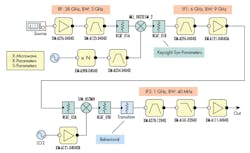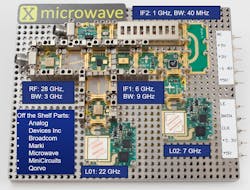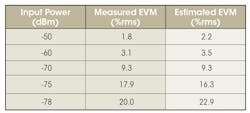Understanding 5G and IoT RF Systems with Off-the-Shelf Components
5G does not mean 5 GHz. 5G is the upcoming fifth-generation wireless mobile network, operating from 24 GHz and up to 95 GHz. It promises extremely high-data-rate wireless connections such as 4K/8K ultra high-definition TV streaming. The Internet of Things (IoT) is another fast-growing application of wireless technology. The IoT is the networking of things around us—from personal gadgets to industrial sensors and freight tracking around the world. By 2020, over 50 billion IoT objects are forecasted to be in operation. This means tremendous work and pressure for RF/microwave engineers to design and build 5G and IoT products quickly to compete for a share of the market.
5G 28-GHz RF System Simulation
Designing and building RF systems to operate at 24 GHz and above is challenging due to the parasitics of interconnects, peripheral biasing, passive components, and the absence of simulation models of available system components. Calculating with spreadsheets and then bread boarding with actual hardware is very costly in terms of time, instrumentation, and effort for all ensuing iterations.
A more efficient approach to design, prototype, and realize RF systems in one pass is now possible and is validated in the example below.
Figure 1 shows the block diagram of a 5G system with a 28-GHz RF input and two down-conversion local oscillators (LOs) at 22 GHz and 7 GHz, respectively. The system produces a 1-GHz intermediate frequency (IF).
1. Shown is a block diagram of a 28-GHz 5G RF receiver system with dual downconversion to 1 GHz. The system was simulated with the Keysight Genesys RF system simulator.
The block diagram is simulated using the Keysight Genesys Spectrasys system simulator with system blocks modeled as:
- X-Parameters for nonlinear circuit data
- Sys-Parameters for system datasheet behavioral data with frequency, bias, and temperature dependence
- S-Parameters for linear circuit data
- Behavioral equation-based models
RF system simulation technology has come a long way since the use of spreadsheets. Improvements in accuracy and diagnostic capabilities are significant. An example of these improvements includes identifying the component origin and frequency equation of nonlinear intermods. This includes knowing the system blocks and their specs in the system line up and how they contribute to performance degradation such as error vector magnitude (EVM), bit error rate (BER), and adjacent channel power ratio (ACPR) under digital modulated RF stimulus.
Figure 2 shows a budget analysis of EVM error versus the system component lineup. This analysis instantly identifies the major contributors of EVM degradation as LO phase noise and linearity of the mixer and amplifiers. Clicking on the culprit components enables their offending specs to be adjusted to improve the system performance. This enables proper selection of the system component lineup without over- or under-specifying them to achieve the best performance with minimum cost.
2. EVM budget analysis can diagnose which components in the RF system lineup are causing degradation to digital modulated RF signals in the system path to prevent wasteful hardware prototype iterations.
Specifying the behavioral specs during the design process and then trying to find real components that have such specs during realization is a common but inefficient approach that will inevitably result in multiple iterations. Sys-Parameters representing simulatable datasheets of real off-the-shelf components or X-Parameters of measured nonlinear components can be used directly in RF system simulation. This way, when the design is complete, parts have also been already specified and verified to work in the system chain. The system is now ready for hardware implementation.
5G System Realization with Off-the-Shelf Parts
Off-the-shelf parts from vendors such as Mini-Circuits, Analog Devices, Qorvo, Marki Microwave, and Broadcom implemented into modular tiles by X-Microwave were used to realize the 28-GHz 5G RF receiver system (Fig. 3). Each modular tile, called an X-Block, includes all the biasing and peripheral passive components for the active device such as LOs, mixers, and amplifiers. They are characterized by measured X-Parameters or Sys-Parameters at their co-planar interconnect reference planes for simulation to accurately model how they are being used in the actual system hardware.
3. Shown is the hardware prototype of the 28-GHz receiver system using X-Blocks from X-Microwave. Discrepancies caused by interconnect parasitics or inaccurate system models are eliminated, allowing for “what-you-simulate-is-what-you-get” accuracy.
The parts are connected by a flipped, co-planar laminate that spans the small gap between the X-Blocks. These laminates are held down by compression without soldering to reliably work up to 67 GHz. The 1.9-mm test launchers are also held down by compression so that the X-Blocks can be reused with no damage. When the prototype is finalized, the same composite layout can be used directly for production, since they are all built on the same laminate material.
When the system was measured, the agreement with the simulated result was unexpectedly close, and is within the uncertainty error of the vector signal analyzer (VSA; see table below).
Designing for the IoT
Multiple standards are emerging for IoT radios based on range of coverage, data bandwidth, and operating frequencies. The IoT frequencies can be broadly divided into two categories: Sub-1-GHz and those above—namely around the 2.4- and 5.8-GHz industrial-scientific-medical (ISM) bands. From the perspective of designing IoT physical radio links that work at these frequency bands, the focus should be on impedance matching the IoT chipset to the antenna. For a longer range, amplifiers may be inserted in between the chipset and the antenna.
Ideally, the impedance matching network must be compact and economical to build. Multi-stage impedance matching over a broad bandwidth (30% or more) to complex frequency-dependent impedances such as an antenna; measured S-parameters of an IoT chipset; or an unstable non-unilateral discrete transistor amplifier is extremely difficult and tedious using traditional Smith chart or benchtop cut-and-try techniques.
A more efficient and optimal approach involves using automatic impedance matching synthesis. This technique employs multiple algorithms from simple L-sections to the Real-Frequency-Technique to address the increasingly difficult aforementioned impedance matching problems. Because synthesis can accomplish difficult simultaneous multi-stage matching in seconds with distributed and/or lumped networks, the IoT radio designer can quickly experiment with multiple matching topologies to select the one that is most economical to build.
Figure 4 shows a three-stage matching network used to match an antenna to a low-noise stabilized transistor amplifier circuit. The measured S-parameters of a chipset power amplifier (PA) are shown, demonstrating a return loss of -20 dB and a gain of 35 dB from 2 to 3 GHz. The microstrip layout dimensions were also synthesized with the automatic insertion of discontinuities, such as tees and open stubs. The entire process was completed within one hour.
4. Shown is the impedance matching synthesis and microstrip layout of a three-stage matching network from 2 to 3 GHz to achieve -20 dB of return loss and 35 dB of gain. The process was completed in less than one hour.
Summary
RF systems for 5G and IoT applications can now be efficiently simulated, prototyped, and produced with off-the-shelf system components thanks to breakthrough diagnostic capabilities that can pinpoint any insufficiently performing components in the system lineup. Accurate X- and Sys-Parameter simulation models of off-the-shelf RF system components enables “what-you-simulate-is-what-you-get” efficiency in going from design to prototype and production with no iterations. Impedance matching synthesis replaces tedious manual design and optimization with an instant selection of various suitable matching topologies for the most economical realization.
To learn more visit www.keysight.com/find/eesof-genesys-info and www.xmicrowave.com.





